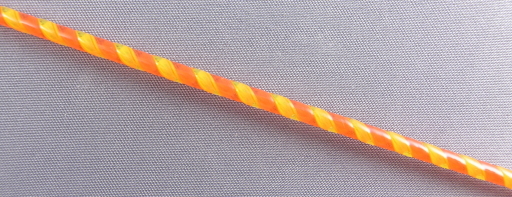I have two sample packs of 96coe glass, that I purchased with the idea of testing with the infamous 7000/8000 thompson enamels (that I must someday finish testing on Bullseye—wish I could get somebody to pay to do this sort of thing...) I never managed to get any clear rods to go with ’em, and made the decision awhile back to "use them up".
Having recently cleaned my studio, (and promised a friend who was coming over the next day that it would be clean) I wanted a project easy to tidy—and then I had a blinding revelation: since I didn't have enough clear or pale transparents to do much with the pi or uroborous sample kits, why not attempt ribbon cane, (which could then be made into twistie hollows) and if it didn't come out just throw it away.

Ribbon cane. "pi" brand 96 coe soda-lime glass (now defunct). Roughly 3mm in diameter; perhaps 18–20” long. 20oct08. There's no bigger version of this image because the camera simply would not focus, and anyway, it's already roughly life size at this resolution.
Oh, the great joy of not having to deal with ugly, failed canes! So of course, this one came out great (by my admittedly low standards for twisted ribbon cane.) There were a couple of reasons for this (at last, finally the how-to part of the post.) You make a ribbon cane, or at least I do by mashing a lollipop, striping if desired (this cane is actually striped with orange on the yellow side, but it barely shows); then plopping big teardrops of clear top and bottom, so that your lollipop is in effect cased in a ball of transparent glass.
There are a variety of items suggested for puntiles—I'm not good enough to get by with the soft-glass rods, and don't like worrying about boro getting stuck. Chopsticks are too difficult to rotate (I never found any of the tubing to make the handles round) but since the ends of steel chopsticks are roughly equivalent to 1/8" mandrels, um, why not just use those? So I started doing that, sometime this year, (probably while making all the floral cane for the crisp floral series) and I like this as a solution.
Since I wanted to use up the glass, I plopped the transparent on generously; and for no good reason, managed to hit just the right moment between too goopy and heavy a skin before twisting. (N.b. you can case the edges of your lollipop—goldstone is a popular choice—but I didn't in this case, as I wanted it to show.)
Another variation is shape a rectangular slab, as opposed to a round lollipop. That's more efficient, I've heard, but harder to do, as I think it's more difficult to judge the clear volume. If you want to try it, shoot for a rectangle encased in a cylinder.
The only thing is, now that I've have this beginners’ luck, I have to try it again. And I know the next 5 or 10 will be wretched. On the other hand, that should handily use up a lot of that glass...
cane: 20oct08; photo, file, 21oct08.
Unless otherwise noted, text, image and objects depicted therein copyright 1996--present sylvus tarn.
Sylvus Tarn